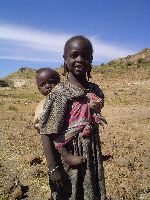Ugandans Return To Their Farms After 20 Years
Thousands Of Ugandans Return To Their Farms After 20 Years In Displaced Camps – UN
New York, Oct 2 2009 3:10PM More than a million Ugandans driven from their homes by decades of violent conflict are gradually moving back to their homeland in the north of the country thanks to an innovative United Nations-backed farming project, the Food and Agricultural Organization (FAO) said today.
A new rice-based farming system aimed at improving food security and reducing poverty in Uganda has enabled the incremental return of around 1.5 million internally displaced persons (IDPs) after living in makeshift camps for more than 20 years.
Although some tensions remain in the absence of a comprehensive peace agreement, armed clashes in the region ended following the conclusion of a peace process in 2006 between the Government and the notorious Lord’s Resistance Army (LRA) rebel group.
“That is when we needed to take action to help people return to their homelands and encourage them to start farming again,” said Percy Misika, FAO Representative in the Ugandan capital, Kampala.
Planting varieties of the high yielding New Rice for Africa (NERICA) rice is the focus of FAO’s cultivation strategy for Uganda, with a project supported by $1.5 million of funding over two years – 2008 to 2010 – from Japan.
“The different NERICA varieties offer a number of advantages: they grow well on the uplands and are resistant to drought, their yield is 30 per cent higher than that of local varieties, and they produce a long grain rice with good flavour and high nutritional content which matures in three months or less when the rains are regular,” said Mr. Misika.
The first phase of the plan, which concluded in 2008, involved eight districts of northern, eastern, central and western Uganda where 1,800 farmers received NERICA varieties, 32 facilitators were trained to teach farmers and 64 farmer field schools were launched.
Since then, nine more northern districts are benefiting from the second phase of the NERICA scheme.
Many of the young households involved are made up of men and women who have no income and who grew up in camps for the displaced without any knowledge of farming and crop cultivation, said FAO.
Those returning to their villages have had to learn about farming, understand effective agricultural practices, and acquire familiarity with the basic production systems used in cultivating NERICA through the project’s Farmer Field School (FFS) network, allowing young farmers can share knowledge.
“We are careful to choose the best profile of facilitator to lead this participatory approach,” said NERICA National Project Manager, Emmanuel Iyamuremye Iyibingira. “It takes passion, motivation and perfectionism to offer effective training for the farmers, especially the young ones who have never known anything except the precarious life of the camps.”
FAO believes that the project will result in more than 2,160 farmers trained in NERICA crop production technology, with a total of 72 schools established in nine districts.
ENDS


 UN News: Ceasefire The Only Way To End Killing And Injuring Of Children In Gaza
UN News: Ceasefire The Only Way To End Killing And Injuring Of Children In Gaza ICHRP: US-Japan-Philippines Trilateral Summit Makes The Philippines A Battlefield For US-China Conflict
ICHRP: US-Japan-Philippines Trilateral Summit Makes The Philippines A Battlefield For US-China Conflict East West Center: Environmental Journalist Alexander Kaufman Receives East-West Center’s Inaugural Melvin M.S. Goo Writing Fellowship
East West Center: Environmental Journalist Alexander Kaufman Receives East-West Center’s Inaugural Melvin M.S. Goo Writing Fellowship Compassion in World Farming: Octopus Farm Must Be Stopped, Say Campaigners
Compassion in World Farming: Octopus Farm Must Be Stopped, Say Campaigners UN News: Shipwreck Tragedy Off Djibouti Coast, Drone Attacks Continue At Ukraine Nuclear Plant, Madagascar Cyclone Update
UN News: Shipwreck Tragedy Off Djibouti Coast, Drone Attacks Continue At Ukraine Nuclear Plant, Madagascar Cyclone Update UN News: Aid Lifeline Reaches Sudan's Darfur Region In Bid To Avert ‘Hunger Catastrophe’
UN News: Aid Lifeline Reaches Sudan's Darfur Region In Bid To Avert ‘Hunger Catastrophe’